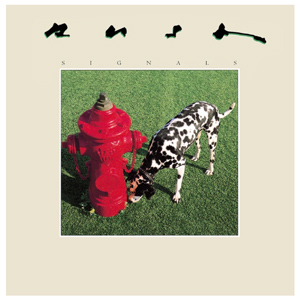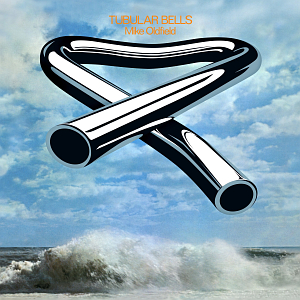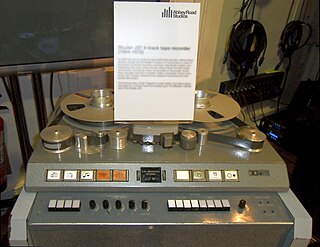
The Mellotron is an electro-mechanical musical instrument developed in Birmingham, England, in 1963. It is played by pressing its keys, each of which causes a length of magnetic tape to contact a capstan, which pulls it across a playback head. As the key is released, the tape is retracted by a spring to its initial position. Different portions of the tape can be played to access different sounds.

Signals is the ninth studio album by Canadian rock band Rush, released on September 9, 1982 by Anthem Records. After the release of their previous album, Moving Pictures, the band started to prepare material for a follow-up during soundchecks on their 1981 concert tour and during the mixing of their subsequent live album Exit...Stage Left. Signals demonstrates the group's continuing use of synthesizers, sequencers, and other electronic instrumentation. It is the last album produced by their longtime associate Terry Brown, who had worked with them since 1974.

The 8-track tape is a magnetic-tape sound recording technology that was popular from the mid-1960s to the early 1980s, when the compact cassette, which pre-dated the 8-track system, surpassed it in popularity for pre-recorded music.

Tubular Bells is the debut studio album by the British musician Mike Oldfield, released on 25 May 1973 as the first album on Virgin Records. It comprises two mostly instrumental tracks. Oldfield, who was 19 years old when it was recorded, played almost all the instruments.

William Nelson is an English singer, guitarist, songwriter, producer, painter, video artist, writer and experimental musician. He rose to prominence as the chief songwriter, vocalist and guitarist of the rock group Be-Bop Deluxe, which he formed in 1972. Nelson has been described as "one of the most underrated guitarists of the seventies art rock movement". In 2015, he was recognised with the Visionary award at the Progressive Music Awards.

More is the third studio album and first soundtrack album by English rock band Pink Floyd. It was released on 13 June 1969 in the United Kingdom by EMI Columbia and on 9 August 1969 in the United States by Tower Records. The soundtrack is for the film of the same name, which was primarily filmed on location on Ibiza and was the directorial debut of Barbet Schroeder. It was the band's first album without former leader Syd Barrett.

An album is a collection of audio recordings issued on a medium such as compact disc (CD), vinyl (record), audio tape, or digital. Albums of recorded sound were developed in the early 20th century as individual 78 rpm records collected in a bound book resembling a photo album; this format evolved after 1948 into single vinyl long-playing (LP) records played at 33+1⁄3 rpm.
Overdubbing is a technique used in audio recording in which audio tracks that have been pre-recorded are then played back and monitored, while simultaneously recording new, doubled, or augmented tracks onto one or more available tracks of a digital audio workstation (DAW) or tape recorder. The overdub process can be repeated multiple times. This technique is often used with singers, as well as with instruments, or ensembles/orchestras. Overdubbing is typically done for the purpose of adding richness and complexity to the original recording. For example, if there are only one or two artists involved in the recording process, overdubbing can give the effect of sounding like many performers.

Pascal Arbez-Nicolas, better known by his stage name Vitalic, is a French electronic music producer.

Pietro Amato is a French horn player with the rock bands Torngat, Bell Orchestre, and The Luyas. He has also performed with Arcade Fire.

Bell Orchestre is a six-piece instrumental band from Montreal. It was formed in 1999 by multi-instrumentalist Richard Parry and violinist Sarah Neufeld. Both also joined Arcade Fire. They were joined in Bell Orchestre by Michael Feuerstack, Stefan Schneider (drums/percussion), Pietro Amato, and Kaveh Nabatian (trumpet/melodica).

Sarah Neufeld is a Canadian violinist who is known for her work with indie rock band Arcade Fire, with whom she is a former core member and currently a touring member. She has contributed to each of the band's studio albums to date. Neufeld is also a member of the instrumental band Bell Orchestre.

It Was Hot, We Stayed in the Water, sometimes shortened to It Was Hot, is the second studio album by American indie folk and indie rock band the Microphones. It was released by K Records on September 26, 2000. After Phil Elverum—the frontman, principal songwriter, and producer of the Microphones's albums—had gained a small following with 1999's Don't Wake Me Up, he recorded It Was Hot in Dub Narcotic Studio in Olympia, Washington, between September 1999 and March 2000. The album was recorded on analogue tape; Elverum embraced the medium's technical imperfections. The album was described as indie rock, lo-fi, and indie pop and was inspired by Elverum's visits to the ocean. As a whole, the album centers on the theme of water, while its lyricism is heavily themed on nature. The 11-minute track "The Glow" acts as the album's climax and introduces the concept of the "glow", which was explored in more depth on 2001's The Glow Pt. 2.
Julia Adamson is a Canadian composer, musician and current label manager of Invisiblegirl Records. In 1967 her family moved to Manchester, England.

Brian Peter George Eno, also mononymously known as Eno, is an English musician, songwriter, record producer and visual artist. He is best known for his pioneering contributions to ambient music and electronica, and for producing, recording, and writing works in rock and pop music. A self-described "non-musician", Eno has helped introduce unconventional concepts and approaches to contemporary music. He has been described as one of popular music's most influential and innovative figures. In 2019, he was inducted into the Rock and Roll Hall of Fame as a member of Roxy Music.
The Man and The Journey tour was an informal concert tour of a few dates by Pink Floyd during which the conceptual music piece The Man and The Journey was played.

Wasting Light is the seventh studio album by American rock band Foo Fighters, released on April 12, 2011, through Roswell and RCA Records. Wanting to capture the essence of their earlier work and avoid the artificiality of digital recording, Foo Fighters recorded the album in the garage of frontman Dave Grohl in Encino, California, using only analog equipment. The sessions were produced by the band alongside Butch Vig, with whom Grohl had worked on Nirvana's Nevermind. Since the old equipment did not allow for many mistakes to be corrected in post-production, the band spent three weeks rehearsing the songs, and Vig had to relearn outdated editing techniques. The band sought a heavier and rawer sound in contrast to the experimentation of their previous albums. Most of the lyrics were written as Grohl reflected upon his life and possible future. Guest musicians include Bob Mould, Krist Novoselic, Jessy Greene, Rami Jaffee and Fee Waybill. Pat Smear played as an official member of the band for the first time since The Colour and the Shape (1997).

All Your Fault: Pt. 1 is the second EP by American singer Bebe Rexha. It was released on February 17, 2017. It features guest appearances from G-Eazy and Ty Dolla $ign. The album's lead single, "I Got You", was released on October 28, 2016.

In music production, the recording studio is often treated as a musical instrument when it plays a significant role in the composition of music. Sometimes called "playing the studio", the approach is typically embodied by artists or producers who favor the creative use of studio technology in record production, as opposed to simply documenting live performances in studio. Techniques include the incorporation of non-musical sounds, overdubbing, tape edits, sound synthesis, audio signal processing, and combining segmented performances (takes) into a unified whole.















